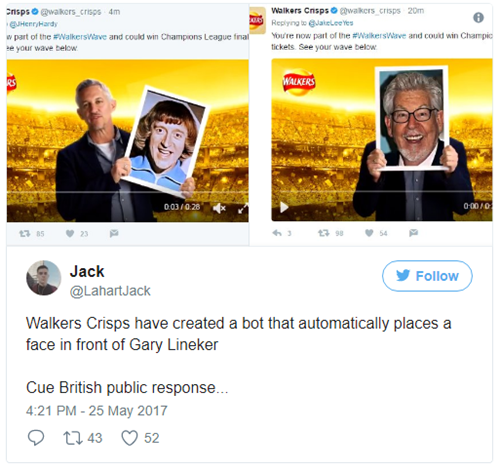Going viral isn’t all it’s cracked up to be
A purple goat advertising cider. Yep, you read that right. Strongbow have just released a new campaign which stars a purple goat to promote the release of its new 95-calorie cider, Strongbow Ultra Dark Fruit. ‘Drink the G.O.A.T’ is definitely a bit different to the usual cider ads featuring orchards and juicy apples, but there is something about it that just smacks of the marketing agency expecting it to go viral. Wacky imagery. Check. Pumping tunes. Check. Targeting Gen Y and Gen Z. Check. Short and sweet. Check. Weird goat noise. Er, check!
To be fair, the ad is part of a £12m nationwide campaign which includes extensive in-store and out-of-home activations, but given they also plan to give the Isle of White Festival an ‘ultra’ makeover, it looks like they may want the goat to go viral. Judging by the noise on social media, or should we say, lack of it, they don’t seem to have succeeded, which isn’t surprising given viral marketing isn’t as easy as it might seem.
We take a look at what it actually takes to go viral and whether it’s really worth it.
What is viral marketing?
Viral marketing is a marketing technique that relies on its audience to organically share and promote a particular marketing message, product, or service. Or to put it another way, you expect your customers to become a brand advocate and do your marketing for free. Clever!
In the good old days (!) this used to be done through word-of-mouth marketing, but nowadays social media, online networks and other digital media are the perfect channels of choice as they allow information to spread quickly and widely across different customer bases. Although most viral campaigns tend to start slowly before gaining momentum at an ever-increasing rate, this isn’t always the case. Old Spice’s “The Man Your Man Could Smell Like” campaign, which was initially launched online over the 2010 Super Bowl weekend, was so successful, (it generated over 40 million views on YouTube, making it the most-watched video on the platform at the time), that they quickly launched a ‘response campaign’. This saw the Old Spice Guy respond to real-time messages and attracted 5.9 million YouTube views in day one and helped double sales.
And if you’re wondering how many views constitutes ‘going viral’, there isn’t a magic figure because every viral campaign is different, but north of 5 million views is a good starting point.
Are there any benefits of going viral?
Obviously for Old Spice, the answer is a resounding yes! Like any marketing, get it right and going viral can help increase brand awareness while allowing you to reach a whole new tranche of consumers. In fact, in real terms something is only viral when it’s being shared by everyone not just your target audience, and as they are doing this for free, it makes it much more cost-effective when compared to traditional advertising campaigns.
And grabbing the attention of a new audience can result in more sales that under normal circumstances could take months or even years to achieve. Just look at DollarShaveClub.com whose fun viral video helped it record 12,000 orders within 2 days and saw it subsequently acquired by Unilever in 2016 for $1 billion!
Going viral can also help with brand credibility and perception, especially if consumers choose to share their own positive experiences. Dove’s ‘You are more beautiful than you think’ video has over 70 million views and people are still heaping praise on how it’s helped them personally despite it going viral over 10 years ago.
Be wary of the potential risks
But that’s not to say going viral is without its downsides. Burger King’s mouldy burger ad made in response to McDonald’s claim their burgers don’t decompose may have generated 8.4 billion impressions and saw sales increase by 14%, but it also saw 26% of viewers being turned off from purchasing a Whooper, and we’ve got to say, we agree with them!
And that’s a major drawback of a campaign going viral – not all reactions (if any!) will be positive. Southern Rail wanted customers to join them in challenging a planned rail strike. Instead, the public decided to create their own hashtag #SouthernFail and lambast the company for their rubbish services!
Time to get back on track. Tweet @RMTunion & tell them how rail strikes make you feel. https://t.co/IVaRAGBBSV #SouthernBackOnTrack pic.twitter.com/lpBcXs9K5f
— Southern (@SouthernRailUK) October 3, 2016
And of course, if you are asking the public to get involved, you can’t blame them for getting, shall we say, a little creative. When Walkers launched its Walkers Wave to celebrate the UEFA Champions League Final in 2017, they asked people to tweet selfies which would be included in a video clip of Gary Lineker holding said selfie. Automating the process seemed like a good idea, that is until images of Jimmy Saville and Rolf Harrisstarted appearing in the campaign. You’ve got to love the British public!

Is it possible to create something that goes viral?
If you look at the examples of Burger King, Old Spice and Dove, the answer seems to be yes, but it’s not that simple. Just because you think something should go viral doesn’t mean it will as the whole point of viral marketing is it’s your audience sharing the information because they want to. It’s why seemingly weird phenomena such as Baby Yoda suddenly seem to take over the internet for no apparent reason (apart from being cute, obviously!), but this does mean you simply can’t guarantee or predict what marketing activity is going to be a viral success.
But there are some things you can do to help nudge your campaign in the right direction:
Identify why you want to go viral
Like all good marketing there needs to be purpose behind it, whether that’s brand awareness, launching a new product (Strongbow’s purple goat) or generating more sales or donations.
Produce good content
This goes without saying, but producing something that is relatable, and genuine is much more likely to go viral than something that is obviously corporate. And you’ll need to find ways to make the content stand out as well – this could be through humour, controversy, or doing something unexpected. A bog-standard ad is highly unlikely to go viral.
Make sure content is easy to share
Sharing should be easy otherwise people won’t do it, so posting something just on your website won’t work. Identify the best types of content (images and video are always good) and give people different ways of sharing, such as on different social media platforms. Then use campaign specific hashtags to spread the word.
Keep an eye on trends
Starting way back in 1991 the Ice Bucket Challenge wasn’t originally linked to any specific charity but then a couple of people took part and gave money to the ALS Association (known as Motor Neurone Disease in the UK). The ALS Association jumped on this idea as a great way of raising both awareness and funds. The campaign went viral with celebrities, politicians and sports stars all getting involved and raised more than $100 million in a 30-day period for research around the world.
This is a good example of how using existing trends can work in your favour. But be warned, trends change quickly and using something that’s out of date could negatively impact your brand.
Should your brand attempt to go viral?
That’s a question only you can answer, although you might find our workshops could help point you in the right direction!
Going viral is hard and there are no guarantees that even if you follow the tips above it will work. Also bear in mind, that although it might help raise awareness of your brand at that point in time, it won’t necessarily translate into more sales or even more future customers. Yes, there are plenty of examples to prove otherwise, but be prepared for it being nothing more than a short-term spike in brand awareness.
And whatever you do, remember to always remain authentic to your brand and your values. That way even if your content doesn’t go viral, you will have still produced something that is worthy of your brand.
